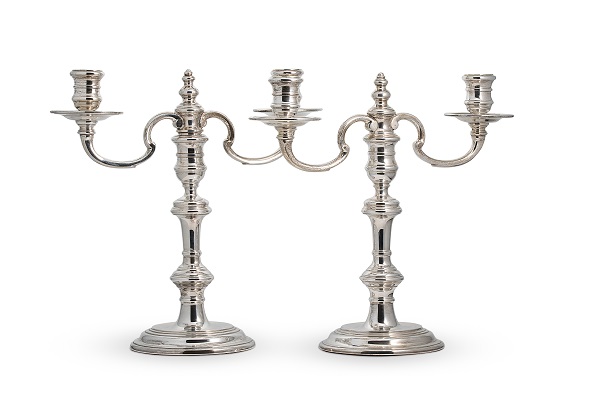With energy prices on the rise and overhead spotlights officially off the style set’s agenda, there is no doubt that candlesticks are some of the most popular items we sell at auction. Adding a polished layer to table décor and casting a wonderful warmth to a home, this is a collecting field which anyone can get involved in.
We have 13 lots of candlesticks in the next Jewellery, Silver & Watches Sale, taking place on the 6th April. It’s an unusually large number, with both antique and modern examples.
When it comes to modern candle holders, style is everything. These are not just things to hold a candle, rather they are design-led collector’s items. Some great examples in the sale are from Scottish designer Graham Stewart (see lot 665) or Birmingham-based Martin Pugh (lot 426). With a focus on clean lines and traditional shapes, these handmade examples can sometimes make over £1000 a pair at auction.

Lot 426 - candlesticks by Martin Pugh, estimate £300 - £500
However, going back to the 18th century and earlier, candlesticks were more of a practical necessity than an ornament. Some silversmiths in times past would have specialised in making solely candlesticks, with some of the most well-known names including the likes of John Cafe, William Cafe and Ebenezer Coker, still commanding high prices today. Sometimes though, bargains can be found with the less famous makers, such as Daniel Smith & Robert Sharp (lot 486) or John Carter II (lot 490), where fantastic examples can sometimes be picked up for around £400 a pair at auction.

Lot 490, candlesticks by John Carter II, estimate £500 - £700
In those days the sticks themselves were made in two different ways. Cast sticks were heavier and stronger and much more resilient to wear and tear – ideal for a game of Cluedo if you happen to be in the library and go by the name of Colonel Mustard! These are easy to identify by their heavier weight and by looking at the underside which is hollow and usually where you would find the hallmarks of the maker. The ‘filled’, ‘loaded’ or ‘weighted’ sticks are usually made of thinner gauge silver and filled inside with a strengthening material, such as pitch or cement. These are usually lighter and easy to spot by looking at the underside which will be flat and usually covered with felt. These examples need a bit closer inspection when buying as they are much more susceptible to damage, denting or ever ‘wearing away’ in places from over-enthusiastic polishing.
Other types of candlesticks to look out for are library sticks, which are usually much shorter, bringing the light of the flame closer to the table – so it is stronger for reading. These are currently popular as they are seen as less obtrusive when on a modern dining table – see lot 541 for an example. There are also metamorphic candlesticks which can be useful, with the ability to be used on their own or to add branches to create candelabras – such as lot 640. Those who love the Victorian Gothic look should seek out multi-branch candelabras. We have two examples of these in the sale, one which is silver plated (lot 442) and one which is a silver five light version (lot 593).

Lot 640, metamorphic candlesticks, estimate £300 - £500
Finally, when extinguishing candles, although it’s fun to ‘blow them out’ it’s much safer if you ‘snuff them out’ with a candle snuffer. Unlike sticks, the conical shaped snuffers have not really changed in design since they were first invented – see lot 427 – made in 1990 by award winning designer Martin Pugh, but which would have looked equally at home on an 18th century dining table. Some things never change…
To view the catalogue for the Jewellery, Silver & Watches Sale, please click here